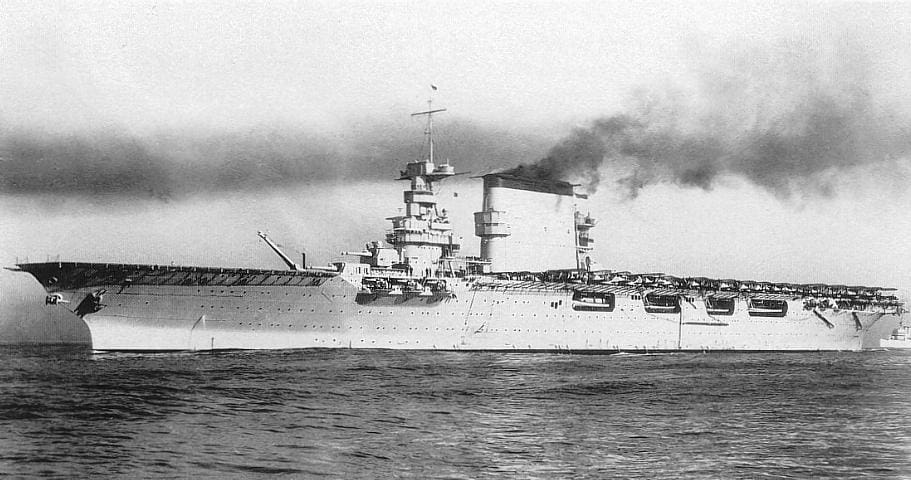The Battle of the Coral Sea is known for being the first Naval battle where the two opposing forces never met. It was the birth of the aircraft carrier. No surface ships sank another ship in this battle. It was also one of the allies’ first victories in the war in the Pacific. It did come at a hefty price for the Allies, at a loss of 1 aircraft carrier, the USS Lexington CV-2, 1 Destroyer USS Sims DD-409, 1 oiler USS Neosho AO-23, 69 aircraft and 656 people killed, the USS Yorktown was also significantly damaged. The Lexington was so severely damaged that the U.S. sank it with torpedo’s the day after the battle. The Japanese lost 1 Light strike carrier (Jeep Carrier), 1 destroyer, 3 small warships, 97 aircraft, and 966 people killed.

My Stepfather was on the Lexington during this battle. He was in a boiler room when a Japanese torpedo hit it. After he abandoned the Lady Lex, he spent the next month and a half making his way back to San Diego before he could get new clothes and a new sea bag. Like every good sailor, he went out and got drunk, losing his seabag and being arrested by shore patrol. He ended up in the brig and had to rent a seabag so he could get out because, if you didn’t have a full seabag, you had to stay in jail. He was one of the most significant people in my life and one of the biggest reasons I joined the Navy. He had great pride in being in the Navy and joined in 1939. He had left Pearl Harbor on December 6, 1941, so they could bring planes to Midway. He was supposed to get out in early 1942.

The allies learned of the intended plan of the Japanese to seize Port Moresby in New Guinea. The Japanese wanted to take control of the Coral Sea and use it as a staging base to invade Australia. When the Japanese landed at Tulagi on May 3, carrier-based U.S. planes from a Task Force 17 struck the landing group, sinking one destroyer and some minesweepers and landing barges. Most of the naval units covering the main Japanese invasion force that left Rabaul, New Britain, for Port Moresby on May 4 took a route to the east, where they clash with TF17.
On May 5 and 6, 1942, opposing carrier groups sought each other, and on the morning of May 7, Japanese carrier-based planes sank a U.S. destroyer and an oiler. Allied planes sank the light carrier Shoho and a cruiser. The next day Japanese aircraft crippled the U.S. carrier Lexington and damaged the carrier Yorktown. U.S. planes crippled the sizeable Japanese carrier Shokaku so bad that it had to retreat away from the battle. So many Japanese planes were lost that the Port Moresby invasion force, without adequate air cover and harassed by Allied land-based bombers, turned back to Rabaul. The four-day engagement was a strategic victory for the Allies. The battle, which U.S. Adm Ernest J. King described as “the first major engagement in naval history in which surface ships did not exchange a single shot,” foreshadowed the kind of carrier warfare that marked later fighting in the Pacific War.
A little over two years ago, the USS Lexington was found at the bottom of the Coral Sea, and she was seen for the first time since she was lost so long ago. God bless all the sailors and airman who are still interned in her and never had a chance to be someone’s Stepfather or live their lives.

news.usni.org/2018/03/05/video-billionaire-paul-allen-finds-lost-world-war-ii-carrier-uss-lexington


This is so important.
It brings tears to this old Marine’s eyes to think of the almost incredible sacrifice, heroism, and courage. People had the same range of emotions as they do today, but those heroes kept the wrong ones at bay, and the proper ones front and center to get their job or task in front them, done.
My Grandfather was one of the first U.D.T. guys, and fought in the Pacific Campaign for it’s entirety.
**Semper Fidelis**
Best overview (that I have seen) of the battle can be found here https://youtu.be/NB5hH3ksvKE
I am actively trying to get Word War I, II, Korea, Vietnam, Grenada, Panama, Gulf War, and Global War On Terror events into my Outlook calendar. This may seem silly to some, but I use it on a daily basis, and this old mind has a harder time remembering the important stuff.
If anyone has a good way to get a batch/mega Calendar upload file for Microsoft Outlook, please kindly let me know. Thank you very much!
Semper Fi.
As a dam furriner, I can never understand why that as ;long as the USN has carriers…they are not named Yorktown, Lexington, Saratoga etc
@Linz, I agree.
This was my father’s generation (USAAF in the Pacific, Abemama and Saipan, 1943-43). Rest in peace gentlemen.
(Late in the article, it should be “interred”, not “interned”.)
A good friend, Bill Dibrell, passed away earlier this year. His father was a pilot on board the Lexington, and was serving as Landing Signal Officer when the ship was recovering aircraft while on fire – Bill told me he’d seen film of his father guiding the airplanes down to land on the burning ship.
When the order came to abandon ship, Bill’s father disregarded SOP instructing sailors to ditch their sidearms, and kept his issued M1911 – I heard these stories from Bill a few times while shooting that pistol at a local range.
Incredible stories. Incredible men.